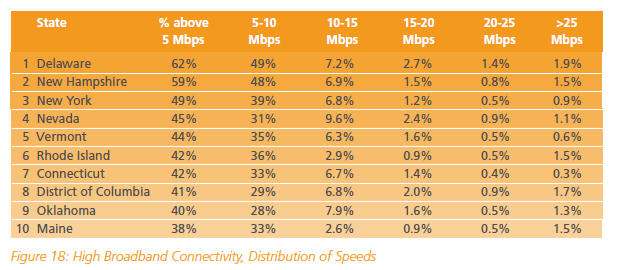The United States of broadband: All of the speed is on the east coast

Akamai's state of the Internet report for the first quarter illustrates the distribution of broadband speeds in the U.S. The real speed appears to be on the east coast.
Here's the distribution of broadband in the top 10 states:
Akamai reports:
In looking at the ten states with the highest levels of high broadband connectivity, we find that the distribution of connection speeds above 5 Mbps generally follows a similar pattern. Unsurprisingly, the majority of the high broadband connections measure between 5-10 Mbps, with the next largest grouping between 10-15 Mbps. After that the faster ‘buckets’ struggle to achieve even 3% of connections, as shown in Figure 18. This distribution of speeds is not surprising, as most residential broadband options offer connections in the 5-15 Mbps downstream range, with higher speed options available only in limited areas or at significantly higher prices. We expect that as the adoption and rollout of DOCSIS 3.0 technology by cable Internet providers, as well as other FTTH initiatives by telecom providers, become more widespread that the percentage of connections in the highest ‘bucket’ will grow over time, and that competitive market pressures will drive providers to price the highest speed tiers of service at a level that subscribers find affordable.
Jason Perlow: Optimum Ultra: So how fast is it?
Here's a look at the states with the highest percentage of speeds topping 25 Mbps.
And here are the slowest states in the union.
Globally, however, the U.S. trails in broadband ranking at No. 33 in Akamai's first quarter tally. The good news: That's up from No. 35 in the fourth quarter.
